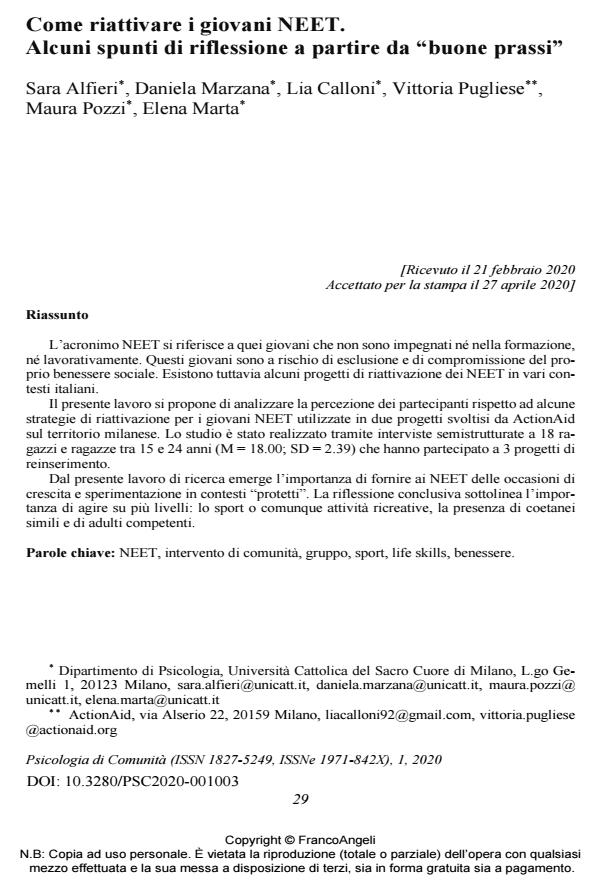How to reactivate young people NEET. Some ideas for thought starting from best practic-es
Journal title PSICOLOGIA DI COMUNITA’
Author/s Sara Alfieri, Daniela Marzana, Lia Calloni, Vittoria Pugliese, Maura Pozzi, Elena Marta
Publishing Year 2020 Issue 2020/1
Language Italian Pages 18 P. 29-46 File size 543 KB
DOI 10.3280/PSC2020-001003
DOI is like a bar code for intellectual property: to have more infomation
click here
Below, you can see the article first page
If you want to buy this article in PDF format, you can do it, following the instructions to buy download credits

FrancoAngeli is member of Publishers International Linking Association, Inc (PILA), a not-for-profit association which run the CrossRef service enabling links to and from online scholarly content.
The acronym NEET refers to those young people who are not engaged in training or work. These young people are at risk of exclusion and reduction of their social well-being. However, there are some projects to reactivate NEETs in various Italian contexts. This work aims to analyze the participants’ perception of some reactivation strategies for young NEETs used in two projects that revolve around the theme of ActionAid in the Milan area. The study was carried out through semi-structured interviews with 18 boys and girls between 15 and 24 years of age (M = 18.00; SD = 2.39), who participated in 3 reactivation projects. From this research work, the importance of providing NEETs with opportunities for growth and experimentation in "protected" contexts emerges. The final reflection underlines the importance of acting on several levels: sport or in any case recreational activities, the pres-ence of peers and competent adults.
Keywords: NEET, community intervention, group, sport, life skills, wellbeing
- Strategies for Engaging and Outreaching NEETs in Italy: Insights From Active Labour Policies Adriano Mauro Ellena, Daniela Marzana, Maura Pozzi, in Politics and Governance 7499/2024
DOI: 10.17645/pag.7499 - Presentazione del numero. Empowerment and social inclusion Immacolata Di Napoli, Sara Alfieri, in PSICOLOGIA DI COMUNITA' 1/2020 pp.5
DOI: 10.3280/PSC2020-001001 - An Analysis of Social Relationships’ Quality Associations with Hope Among Young Italians: the Role of NEET Status Francisco Simões, Elena Marta, Daniela Marzana, Sara Alfieri, Maura Pozzi, in Journal of Applied Youth Studies /2021 pp.169
DOI: 10.1007/s43151-021-00034-8
Sara Alfieri, Daniela Marzana, Lia Calloni, Vittoria Pugliese, Maura Pozzi, Elena Marta, Come riattivare i giovani NEET. Alcuni spunti di riflessione a partire da "buone prassi" in "PSICOLOGIA DI COMUNITA’" 1/2020, pp 29-46, DOI: 10.3280/PSC2020-001003